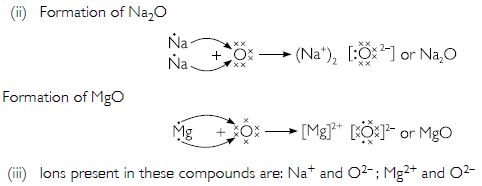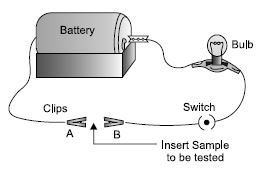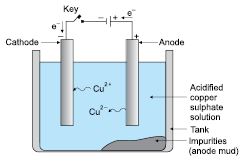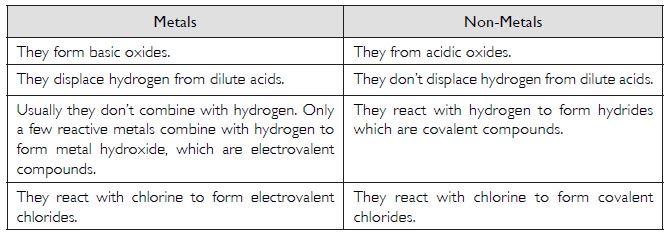Question 1:
Zinc liberates hydrogen gas when reacted with dilute hydrochloric acid, whereas copper does not. Explain why?
Answer:
Zinc lies above hydrogen whereas copper lies below hydrogen in the activity series of metals. Therefore, zinc displaces hydrogen from dilute hydrochloric acid, while copper does not.
Question 2:
What happens when zinc granules are treated with dilute solution of H2SO4, HCl, HNO3, NaCl and NaOH; also write the chemical equations if reaction occurs.
Answer:
A. The reaction of Zn granules with dilute acids results in the formation of hydrogen gas.
Reaction with dilute H2SO4
Zn(s) + H2SO4(aq) → ZnSO4(aq) + H2(g)
Reaction with dilute HCl
Zn(s) + 2HCl(aq) → ZnCl2(aq) + H2(g)
Reaction with dilute HNO3
Zn(s) + 2HNO3(aq) → Zn(NO3)2(aq) + H2(g)
Since nitric acid is an oxidising agent, it oxidises H2 gas to H2O.
B. As zinc lies below Na in the activity series, no reaction takes place between zinc and
NaCl solution.
Zn(s) + NaCl(aq) → No reaction
C. With the solution of sodium hydroxide also, zinc granules react to form hydrogen gas.
Zn + 2NaOH + H2O → Na2Zn(OH)4 + H2
Question 3:
You are provided with two containers made up of (i) copper and (ii) aluminium. You are also provided with solutions of dilute HCl, dilute HNO3, ZnCl2 and H2O. In which of the above containers these solutions can be kept?
Answer:
A. In the case of copper container:
1. Dilute HCl does not react with copper. Therefore, it can be kept.
2. Dilute HNO3 is a strong oxidising agent and reacts with copper vessel;
therefore, it cannot be
kept.
3. Since zinc is more reactive than copper, therefore no displacement reaction occurs
between
ZnCl2 and copper. Therefore, ZnCl2 solution can be kept.
4. H2O does not react with copper. Therefore, it can be kept.
B. In the case of aluminium container:
1. Dilute HCl reacts with aluminium to form a salt and hydrogen gas. Therefore, it cannot be
kept.
2Al + 6HCl → 2AlCl3 + 3H2
2. Dilute HNO3 oxidises aluminium to Al2O3 and thus cannot be kept.
3. Aluminium being more reactive than zinc can displace zinc ion from the ZnCl2
solution.
Therefore, this solution cannot be kept.
2Al + 3ZnCl2 → 2AlCl3 + 3Zn
4. Aluminium does not react with cold or hot water. Therefore, water can be kept.
Question 4:
Give an example of a metal which:
(i) is a liquid at room temperature.
(ii) can be easily cut with a knife.
(iii) is the best conductor of heat.
(iv) is a poor conductor of heat.
Answer:
(i) Mercury
(ii) Sodium
(iii) Silver
(iv) Lead
Question 5:
Explain the meaning of malleable and ductile.
Answer:
Malleable: A substance is said to be malleable if it can be beaten into sheets. For example,
iron, gold,
silver are malleable.
Ductile: A substance is said to be ductile if it can be drawn into wires. For example,
copper, silver, gold
are ductile.
Question 6:
Why does sodium kept immersed in kerosene oil?
Answer:
Sodium metal is highly reactive. If it is kept open, it can explosively react with oxygen and moisture present in the air. To prevent this explosive reaction and the after effects, sodium is kept immersed in kerosene.
Question 7:
Write equation for the reactions of:
(i) iron with steam
(ii) calcium and potassium with water.
Answer:

Question 8:
Samples of four metals A, B, C and D were taken and added to the following solutions one by
one.
The results obtained have been tabulated as follows:

Use the table above to answer the following questions about metals, A, B, C and D.
(i) Which is the most reactive metal?
(ii) What would you observe if B is added to a solution of copper (II) sulphate?
(iii) Arrange the metals A, B, C and D in the order of decreasing reactivity.
Answer:
(i) B is the most reactive metal.
(ii) B will displace copper from copper sulphate solution.
(iii) The decreasing order of reactivity is:
B > A > C > D
Question 9:
Which gas is produced when dilute hydrochloric acid is added to a reactive metal? Write the chemical reaction when iron reacts with dilute H2SO4.
Answer:
Hydrogen gas is produced when dilute hydrochloric acid is added to a reactive metal. The chemical reaction between iron and dilute

Question 10:
What would you observe when zinc is added to a solution of iron (II) sulphate? Write the chemical reaction that takes place.
Answer:
When zinc is added to a solution of iron (II) sulphate, it will displace iron from it and light green colour of solution gradually fades away.
Question 11:
(i) Write the electron-dot structures for sodium, oxygen and magnesium.
(ii) Show the formation of Na2O and MgO by the transfer of electrons.
(iii) What are the ions present in these compounds?
Answer:
(i) Electron-dot structures for sodium, oxygen and magnesium are


Question 12:
Why do ionic compounds have high melting points?
Answer:
Ionic compounds have strong electrostatic forces of attraction between oppositely charged ions. A considerable amount of energy is required to break these forces of attraction. Thus, ionic compounds have high melting points.
Question 13:
Define the terms: (a) mineral (b) ore (c) gangue
Answer:
(a) Mineral: The free or combined states of elements naturally occurring in the earth’s
crust are called
minerals.
(b) Ore: An ore is a mineral from which a metal can be extracted conveniently and
economically.
(c) Gangue: The earthy impurities such as sand, lime stone, rocks etc. associated with
minerals are
collectively known as gangue or matrix.
Question 14:
Name two metals which are found in nature in the free state.
Answer:
Gold and platinum.
Question 15:
What chemical process is used for obtaining a metal from its oxide?
Answer:
Reduction process.
Question 16:
Metallic oxides of zinc, magnesium and copper were heated with the following metals:

In which cases will you find displacement reactions taking place?
Answer:

Zinc can displace copper from copper oxide.

Magnesium can displace zinc and magnesium from zinc oxide and magnesium oxide respectively.

Question 17:
Which metals do not corrode easily?
Answer:
Less reactive metals that are not attacked by air and moisture don’t corrode easily. For example, gold, platinum.
Question 18:
What are alloys?
Answer:
Alloys are the homogeneous mixtures of two or more metals or metals and non-metals.
Question 19:
Which of the following pairs will give displacement reactions?
- NaCl solution and copper metal
- MgCl2 solution and aluminium metal
- FeSO4 solution and silver metal
- AgNO3 solution and copper metal
Answer:
AgNO3 solution and copper metal
Question 20:
Which of the following methods is suitable for preventing an iron frying pan from rusting?
- applying grease
- applying paint
- applying a coating of zinc
- All of the above
Answer:
applying a coating of zinc
Question 21:
An element reacts with oxygen to give a compound with a high melting point. This compound is also soluble in water. The element is likely to be:
- calcium
- carbon
- silicon
- iron
Answer:
calcium
Question 22:
Food cans are coated with tin and not with zinc because:
- zinc is costlier than tin
- zinc has a higher melting point than tin
- zinc is more reactive than tin
- zinc is less reactive than tin
Answer:
zinc is more reactive than tin
Question 23:
You are given a hammer, a battery, a bulb, wires and a switch.
(i) How could you use them to distinguish between samples of metals and non-metals?
(ii) Assess the usefulness of these tests in distinguishing between metals and non-metals.
Answer:
(i) Using the given battery, bulb, wires and switch, set up
an electric circuit as shown below. Then, insert the
samples between clips A and B one by one. If the bulb
glows, the sample is a metal. If the bulb does not glow,
the sample is a non-metal.
Likewise, beat the samples using the given hammer
one by one. If a sample can be beaten into a thin
sheet, it is a metal otherwise it is a non-metal.

(ii) These tests are useful in distinguishing between metals and non-metals on the basis of
their
electrical conductivity and malleability. Metals are good conductor of electricity whereas
nonmetals
are bad. Metals are malleable whereas non-metals are non-malleable.
Question 24:
What are amphoteric oxides? Give two examples of amphoteric oxides.
Answer:
Amphoteric oxides are the oxides which react with acids as well as bases to produce salts
and water.
Examples are zinc oxide, ZnO and aluminium oxide, Al2O3.
Question 25:
Name two metals which will displace hydrogen from dilute acids, and two metals which will not.
Answer:
Zinc and magnesium can displace hydrogen from dilute acids. Copper and silver cannot displace hydrogen from dilute acids.
Question 26:
In the electrolytic refining of a metal M, what would you take as the anode, the cathode and the electrolyte?
Answer:
During the electrolytic refining of a metal M, the impure metal is made as anode, a thin
strip of pure
metal M is made as cathode and a salt solution of metal M is made as the electrolyte.
Question 27:
Pratyush took sulphur powder on a spatula and heated
it. He collected the gas evolved by inverting a test tube
over it as shown in figure.
(a) What will be the action of gas on
(i) dry litmus paper?
(ii) moist litmus paper?
(b) Write a balanced chemical equation for the reaction
taking place.

Answer:
(a) (i) No action
(ii) It turns moist blue litmus paper red.

Question 28:
State two ways to prevent the rusting of iron.
Answer:
The rusting of iron can be prevented by:
(1) preventing the contact of iron surface with air and moisture by painting, oiling or
greasing.
(2) by coating the iron surface with a more reactive element like zinc. This is called
galvanisation.
Question 28:
What type of oxides are formed when non-metals combine with oxygen?
Answer:
Non-metals form two types of oxides.
(a) Neutral oxides such as CO, NO etc.
(b) Acidic oxides such as SO2, CO2 etc.
Question 29:
Give reasons:
(a) Platinum, gold and silver are used to make jewellery.
(b) Sodium, potassium and lithium are stored under oil.
(c) Aluminium is a highly reactive metal, yet it is used to make utensils for cooking.
(d) Carbonate and sulphide ores are usually converted into oxides during the process of
extraction.
Answer:
(a) Platinum, gold and silver are used to make jewellery because they have low reactivity
and are
not attacked by air and moisture. They don’t undergo corrosion and retain their lustre for a
long
time. Also these metals are highly malleable and ductile.
(b) Sodium, potassium and lithium are highly reactive and their reactions with air and
moisture are
highly explosive. To prevent these explosive reactions, these metals are stored under oil.
(c) This is due to the reason that a thin oxide layer of aluminium is formed on its surface
which
prevents the further oxidation of metal. The oxide layer is stable even at high
temperatures. Also
aluminium is a good conductor of heat.
(d) This is because it is easier to obtain a metal from its oxide as compared to its
sulphide or
carbonate.
Question 30:
You must have seen tarnished copper vessels being cleaned with lemon or tamarind juice. Explain why these sour substances are effective in cleaning the vessels.
Answer:
In case of a tarnished copper vessel, there is a layer of basic copper carbonate. This basic layer can be cleaned by using sour substances such as lemon or tamarind juice which are acidic in nature and can dissolve the basic coating of copper carbonate.
Question 31:
Differentiate between metal and non-metal on the basis of their chemical properties.
Answer:
Question 32:
A man went door to door posing as a goldsmith. He promised to bring back the glitter of old and dull gold ornaments. An unsuspecting lady gave a set of gold bangles to him which he dipped in a particular solution. The bangles sparkled like new but their weight was reduced drastically. The lady was upset but after a futile argument the man beat a hasty retreat. Can you play the detective to find out the nature of the solution he had used?
Answer:
The solution used by goldsmith to bring back the glitter of old and dull gold ornaments was aqua regia. It is a freshly prepared mixture of conc. HCl and conc. HNO3 in the ratio 3 : 1. It can dissolve gold.
Question 33:
Give the reason why copper is used to make hot water tanks and not steel (an alloy of iron).
Answer:
Copper does not react with water or steam and thus can be used to make water tanks. In contrast, iron reacts with steam. Therefore, if a hot water tank is made of steel, the iron present in steel would react with steam formed from hot water. Therefore, steel is not used for making hot water tanks. 3Fe (s) + 4H2O(g) → Fe3O4 + 4H2(s)
Question 34:
Iqbal treated a lustrous, divalent element M with sodium hydroxide. He observed the formation of bubbles in reaction mixture. He made the same observations when this element was treated with hydrochloric acid. Suggest how he can identify the produced gas. Write chemical equations for both the reactions.
Answer:
The produced gas is H2. It can be identified by bringing a burning match stick
near the reaction vessel, as a result of which, a pop sound is produced

Question 35:
During extraction of metals, electrolytic refining is used to obtain pure metals.
(a) Which material will be used as anode and cathode for refining of silver metal by this
process?
(b) Suggest a suitable electrolyte also.
(c) In this electrolytic cell, where do we get pure silver after passing electric current?
Answer:
(a) Anode: Impure silver
Cathode: Pure silver
(b) Electrolyte: Solution of a silver salt, such as AgNO3 or AgCl
(c) At the cathode
Question 37:
Why should the metal sulphides and carbonates be converted to metal oxides in the process of extraction of metal from them?
Answer:
It is done so because to obtain metal from its oxide by reduction is easier than getting metal from its sulphide or carbonate.
Question 38:
Generally, when metals are treated with mineral acids, hydrogen gas is liberated but when metals (except Mn and Mg), treated with HNO3, hydrogen is not liberated. Why?
Answer:
It is so because HNO3 is a strong oxidising agent. It oxidises the hydrogen gas liberated to H3O.
Question 39:
Compound X and aluminium are used to join railway tracks. (a) Identify the compound X. (b) Name the reaction. (c) Write down the reaction.
Answer:
Question 40:
When a metal X is treated with cold water, it gives a basic salt Y with molecular formula XOH (Molecular mass = 40) and liberates a gas Z which easily catches fire. Identify X, Y and Z also write the reaction involved.
Answer:
Question 41:
A non-metal X exists in two different forms Y and Z. Y is the hardest natural substance, whereas Z is a good conductor of electricity. Identify X, Y and Z.
Answer:
X is carbon, Y is diamond and Z is graphite.
Question 42:
The following reaction takes place when aluminium powder is heated with MnO2

(a) Is aluminium getting reduced?
(b) Is MnO2 getting oxidised?
Answer:
(a) No, as oxygen is added to aluminium, it is getting oxidised.
(b) No, as manganese is losing oxygen, it is getting reduced.
Question 43:
What are the constituents of solder alloy? Which property of solder makes it suitable for welding electrical wires?
Answer:
Solder is an alloy of lead and tin. Because of its low melting point, it is suitable for welding electrical wires.
Question 44:
A metal A, which is used in thermite process, when heated with oxygen gives an oxide B, which is amphoteric in nature. Identify A and B. Write down the reactions of oxide B with HCl and NaOH.
Answer:
A is aluminium and B is Al2O3.

Question 45:
A metal that exists as a liquid at room temperature is obtained by heating its sulphide in the presence of air. Identify the metal and its ore and give the reaction involved.
Answer:
Mercury is the only metal that exists as liquid at room temperature. It can be obtained by
heating
cinnabar (HgS), the sulphide ore of mercury. The reaction involved is:

Question 45:
Give the formulae of the stable binary compounds that would be formed by the combination of
following pairs of elements.
(a) Mg and N2 (b) Li and O2 (c) Al and Cl2 (d) K and
O2
Answer:
Mg3N2 (b) Li2O (c) AlCl2 (d) K2O
Question 46:
What happens when
(a) ZnCO3 is heated in the absence of oxygen?
(b) a mixture of Cu2O and Cu2S is heated?
Answer:
(a) It undergoes calcination. The chemical reaction can be given as

(b) It undergoes auto reduction forming copper and sulphur dioxide

Question 47:
A non-metal A is an important constituent of our food and forms two oxides B and C. Oxide B
is
toxic whereas C causes global warming.
(a) Identify A, B and C.
(b) To which group of periodic table does A belong?
Answer:
(a) A is carbon, B is carbon monoxide and C is carbon dioxide.
(b) A belongs to Group – 14 of the periodic table.
Question 48:
Give two examples each of the metals that are good conductors and poor conductors of heat respectively.
Answer:
(a) Good conductors of heat: silver and copper
(b) Poor conductors of heat: lead and mercury
Question 49:
Name one metal and one non-metal that exist in liquid state at room temperature. Also name two metals having melting point less than 310 K (37°C).
Answer:
Metal: Mercury (Hg); Non-metal: Bromine (Br) Two metals with melting points less than 310 K are cesium (Cs) and gallium (Ga).
Question 50:
An element A reacts with water to form a compound B which is used in white washing. The compound B on heating forms an oxide C which on treatment with water gives back B. Identify A, B and C and give the reactions involved.
Answer:
Question 51:
An alkali metal A gives a compound B (molecular mass = 40) on reacting with water. The compound B gives a soluble compound C on treatment with aluminium oxide. Identify A, B and C and give the reaction involved.
Answer:
Question 52:
Give the reaction involved during extraction of zinc from its ore by:
(a) roasting of zinc ore
(b) calcination of zinc ore.
Answer:
Question 53:
A metal M does not liberate hydrogen from acids but reacts with oxygen to give a black colour product. Identify M and black coloured product and also explain the reaction of M with oxygen.
Answer:
M is copper and the black product is CuO.

Question 54:
An element A forms an oxide A2O3 which is acidic in nature. Identify A as a metal or non-metal.
Answer:
Since the oxide of the element A is acidic, it is a non-metal.
Question 55:
A solution of CuSO4 was kept in an iron pot. After few days the iron pot was found to have a number of holes in it. Explain the reason in terms of reactivity. Write the equation of the reaction involved.
Answer:
Iron is more reactive than copper. Therefore, iron displaces copper from CuSO4
solution and forms
FeSO4 solution.

Question 56:
A non-metal A which is the largest constituent of air, when heated with H2 in 1 :
3 ratio in the
presence of catalyst (Fe) gives a gas B. On heating with O2 it gives an oxide C.
If this oxide is passed
into water in the presence of air it gives an acid D which acts as a strong oxidising agent.
(a) Identify A, B, C and D.
(b) To which group of periodic table does this non-metal belong?
Answer:
(a) A is N2, B is NH3, C is NO and D is HNO3.
(b) Element A belongs to Group — 15 of the periodic table.
Question 57:
Give the steps involved in the extraction of metals of low and medium reactivity from their respective sulphide ores.
Answer:
The extraction of metals of low reactivity from their sulphide ores involves following
steps:
(i) Roasting: In this step, the ore is heated strongly in excess of air as a result of which
it gets
converted to metal oxide.
(ii) On further heating the metal oxide, the metal is obtained.
(iii) The metal so obtained is then refined to obtain the pure-metal.
The extraction of metals of medium reactivity from their sulphide ores involves following
steps:
(i) Roasting: In this process, the sulphide ore is converted to metal oxide by heating it in
excess of
air.

(ii) The metal oxide is then reduced to the metal by heating with a suitable reducing agent
like
carbon or aluminium.

(iii) The metal thus obtained is the refined to obtain the pure metal.
Question 58:
Explain the following:
(a) Reactivity of Al decreases if it is dipped in HNO3.
(b) Carbon cannot reduce the oxides of Na or Mg.
(c) NaCl is not a conductor of electricity in solid state whereas it does conduct
electricity in
aqueous solution as well as in molten state.
(d) Iron articles are galvanised.
(e) Metals like Na, K, Ca and Mg are never found in their free state in nature.
Answer:
(a) It is due to the formation of a layer of oxide Al2O3 on the
surface of it.
(b) Na or Mg is more reactive as compared to carbon.
(c) In solid NaCl, the movement of ions is not possible due to the strong electrostatic
forces of
attraction between the oppositely charged ions. However, in aqueous or molten state, the
ions
can move freely and conduct electricity.
(d) To protect them from rusting, iron articles are coated with a layer of zinc by
galvanisation.
(e) It is so because these metals are highly reactive.
Question 59:
(i) Given below are the steps for extraction of copper from its ore. Write the reactions
involved.
(a) Roasting of copper (I) sulphide.
(b) Reduction of copper (I) oxide with copper (I) sulphide.
(c) Electrolytic refining.
(ii) Draw a neat and well labelled diagram for electrolytic refining of copper.
Answer:

Diagram for electrolytic refining of copper

Question 60:
Of the three metals X, Y and Z, X reacts with cold water, Y with hot water and Z with steam only. Identify X, Y and Z and also arrange them in the increasing order of reactivity.
Answer:
X is an alkali metal like Na or K, Y is an alkaline earth metal like Mg or Ca and Z is Fe. Increasing order of reactivity: Na or K > Mg or Ca > Fe
Question 61:
An element A burns with golden flame in air. It reacts with another element B with atomic number 17 to give a product C. An aqueous solution of product C on electrolysis gives a compound D and liberates hydrogen. Identify A, B, C and D. Also write down the equations for the reactions involved.
Answer:
A is Na, B is Cl2, C is NaCl and D is NaOH.

Question 62:
Two ores A and B were taken. On heating, ore A gives CO2 whereas, ore B gives SO2. What steps will you take to convert them into metals?
Answer:
Since ore A gives CO2 and ore B gives SO2. Therefore, these ores are
MCO3 and MS respectively.
Metal M can be obtained from A as shown below:

Metal M can be obtained from B as given below:







